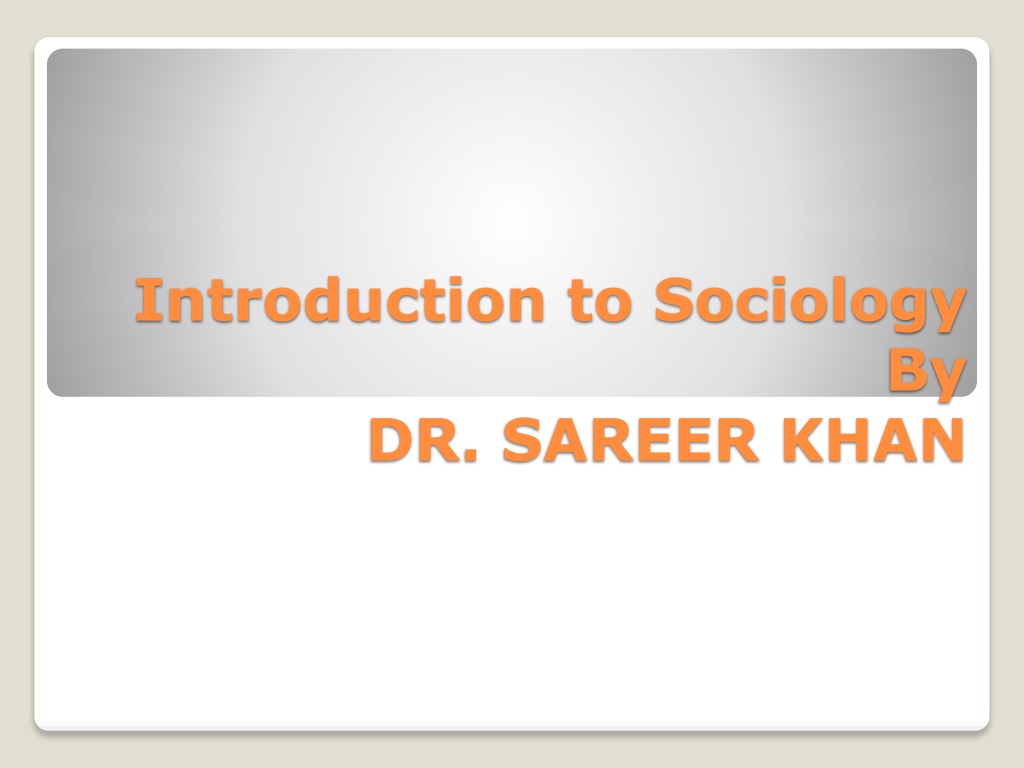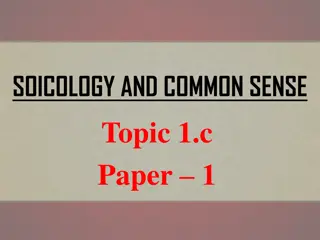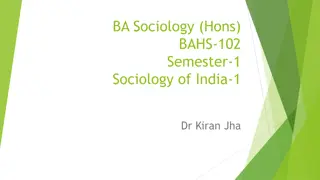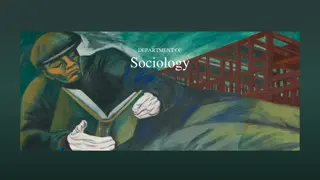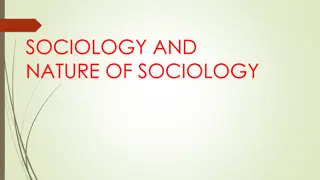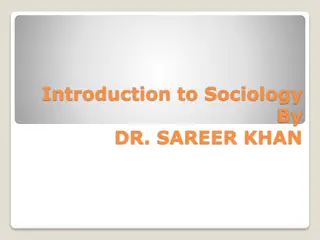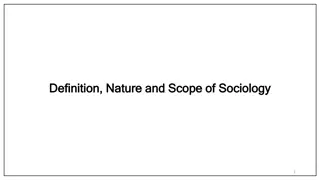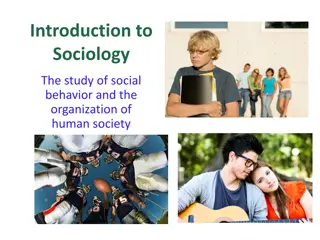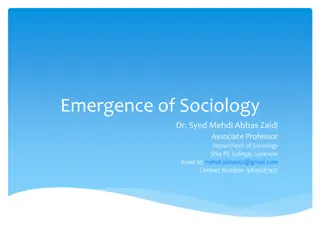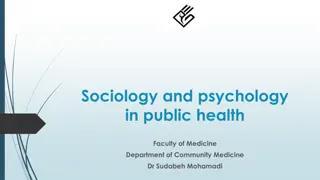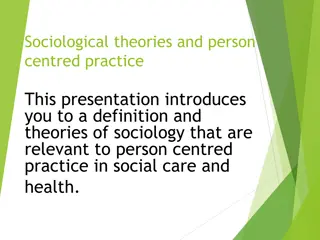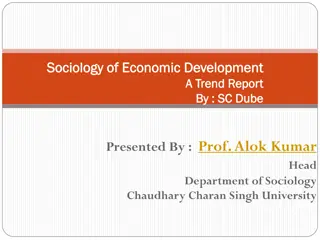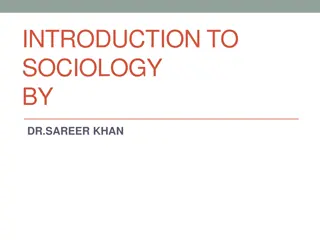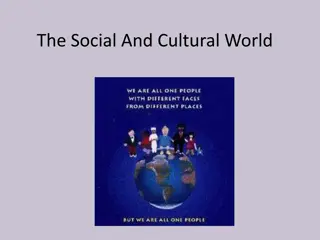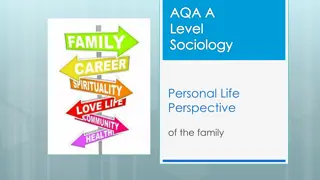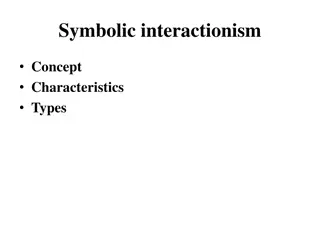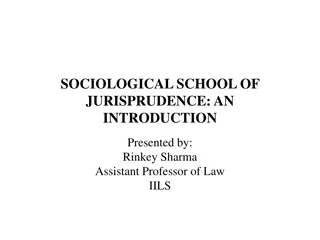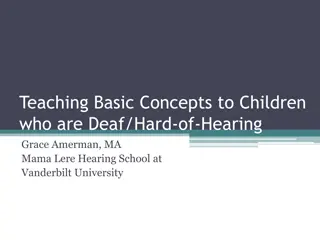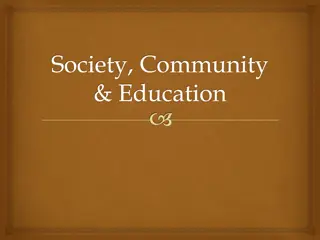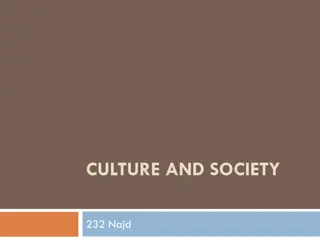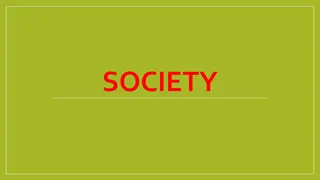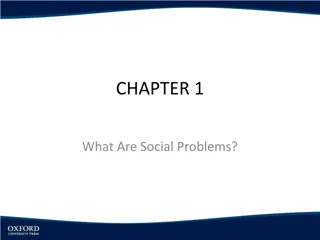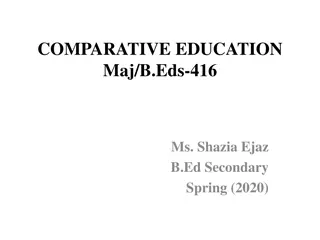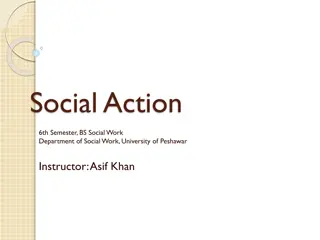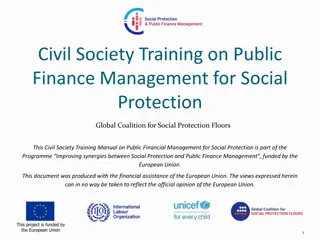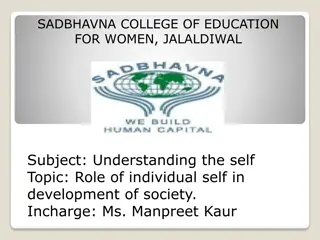Understanding Society: Basic Concepts of Sociology
Society, derived from the Latin word Socius meaning companionship, is a dynamic web of relationships that satisfy members' needs and foster a sense of belonging. Societies are characterized by cooperation, dependence, division of labor, and distinct social institutions. Factors like geography, biology, and socio-cultural elements form the basis of societies, which can vary from static to industrial, rural to urban.
Download Presentation

Please find below an Image/Link to download the presentation.
The content on the website is provided AS IS for your information and personal use only. It may not be sold, licensed, or shared on other websites without obtaining consent from the author. Download presentation by click this link. If you encounter any issues during the download, it is possible that the publisher has removed the file from their server.
E N D
Presentation Transcript
Introduction to Sociology By DR. SAREER KHAN
CHAPTER NO: 02 BASIC CONCEPTS OF SOCIOLOGY
Society The word Society is taken from Latin word Socius which means Association or Companionship . So literally it means A large group of people who are associative with each other is called society.
Society is defined by different Sociologists Maciver According to Maciver, Society is a web of relationship which is always changing. Prof. Wright It is a system of relationship that exists among the individuals of the groups. Linton Any group of people who have lived and work together long enough to organized them selves and to consider them as a social unit with well defined limits.
CHARACTERISTICS OF SOCIETY Society is the largest group of people. It satisfies the needs of its members. One of the characteristic of society is having sense of belonging and cooperation. It is more or less permanent association It is abstract (Because social relationships can be felt and imagined and cannot be seen). Everyone in society is dependent upon every other member.
It should be organized i.e. will be having division of labor It will be having likeness and differences. Due to these differences, variety in human behaviors and division of labor and specialization of roles is there. It is always changing It will form a social structure through social institutions i.e. family, education economic, political and religious institutions. These basic five institutions are found in all societies of the world. Every society has its own culture
Basis of Society There are three major factors which form basis of society. 1. Geographical factor 2. Biological factor 3. Socio-Cultural factor
Types of Society 1. Static Society 2. Modern Society 3. Nomadic Society 4. Sedentary Society 5. Rural Society 6. Urban Society 7. Industrial Society 8. Secular Society 9. Sacred Society 10.Primitive Society
Community Community is taken from two Latin words. Com ------------ Munis --------- Together To Serve To Serve together is called Community.
Definitions of Community Community is defined by different Sociologists. W. Ogburn: Total organization of Social life with in a limited area. Davis It is the smallest territorial group that can embrace all aspects of Social life. Bogardes: It is a social group with some degree of We feeling and living in limited area.
Basic Elements of Community Locality Group of People Sentiments Common Life Growth of Culture Permanence Particular Name
Essentials of Community Community has the following essentials. Physical Part Services Means of Production and Employment Social Relationships A. Primary Relations B. Secondary Relations C. Tertiary Relations
Characteristics of Community Territory Needs Fulfillment Sense of Belonging Face to face interaction Common Culture Same Profession Inter Dependency Norms
Social Group A group is became social when interaction interplays among its participants. Social interaction is its basic condition. People walking in markets, in fairs, travelling in train are not social groups. Because social interaction among them does not exist. Two persons, in America and Pakistan, having interaction on telephone form it although they are far away from each other. Therefore social interaction is the basic condition of social groups.
Social Group Definition According to Nimkoff: When two or more persons are interaction with one another. MacIver says: Any collection of human beings who are brought in to the social relations with one another". Merill says: When two or more persons are in communication for a particular period of time with a common purpose is called group. in the state of
Essentials of Social Group There must be at least two person for a group. There must be communication/interaction among the members. People will have common interest. There must be social structure of groups. There is dependency among the groups.
Characteristics of Social Groups The basis of grouping may be numerous but the division of population on the basis of age, sex, income, profession and other gave them various types of social groups. Following are the character tics. Two or More individuals forms a group. Reciprocal Relations exists among the its members These are formed for Common Goals and Objectives Having Sense of unity and solidarity which results loyalty and sympathy A strong sense of we-feeling which develop cooperation
Group Norms and regulations (written or unwritten) must be followed for group control Similar Behavior to achieve common goals Awareness about its membership to differentiate them from other groups These are dynamic instead static Group Control (direct or indirect control) for members activities
Types of Social Group Following are types of Social groups on different basis. 1. On the basis of Size (By Simmel) 2. On the basis of Structure (Sanderson) 3. On the basis of contacts (C.H. Cooley) 4. On the basis of relations (Hasen) 5. On the basis of Identification (Sumner)
On the Basis of Size 1. Diad Group 2. Triad Group 3. Larger Group
On the basis of Structure 1. Involuntary Group 2. Voluntary Group 3. Delegate Group
On the basis of Contact Primary Group Secondary Group
On the basis of Relations 1. Un-Social Group 2. Anti-Social Group 3. Pro-Social Group
On the basis of Identification In-Group Out-Group
